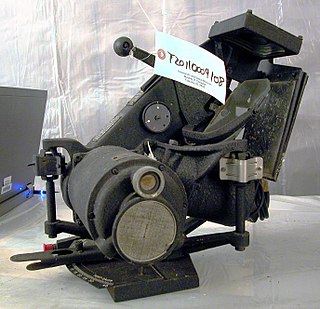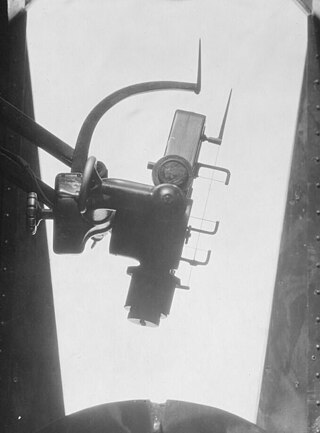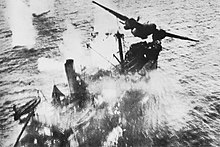
A bomber is a military combat aircraft that utilizes air-to-ground weaponry to drop bombs, launch torpedoes, or deploy air-launched cruise missiles. Bombs were first dropped from an aircraft during the Italo-Turkish War, with the first major deployments coming in the First World War and Second World War by all major airforces, damaging cities, towns, and rural areas. The first bomber planes in history were the Italian Caproni Ca 30 and British Bristol T.B.8, both of 1913. Some bombers were decorated with nose art or victory markings.

A dive bomber is a bomber aircraft that dives directly at its targets in order to provide greater accuracy for the bomb it drops. Diving towards the target simplifies the bomb's trajectory and allows the pilot to keep visual contact throughout the bomb run. This allows attacks on point targets and ships, which were difficult to attack with conventional level bombers, even en masse.

An attack aircraft, strike aircraft, or attack bomber is a tactical military aircraft that has a primary role of carrying out airstrikes with greater precision than bombers, and is prepared to encounter strong low-level air defenses while pressing the attack. This class of aircraft is designed mostly for close air support and naval air-to-surface missions, overlapping the tactical bomber mission. Designs dedicated to non-naval roles are often known as ground-attack aircraft.

The Norden Mk. XV, known as the Norden M series in U.S. Army service, is a bombsight that was used by the United States Army Air Forces (USAAF) and the United States Navy during World War II, and the United States Air Force in the Korean and the Vietnam Wars. It was an early tachometric design, which combined optics, a mechanical computer, and an autopilot for the first time to not merely identify a target but fly the airplane to it. The bombsight directly measured the aircraft's ground speed and direction, which older types could only estimate with lengthy manual procedures. The Norden further improved on older designs by using an analog computer that continuously recalculated the bomb's impact point based on changing flight conditions, and an autopilot that reacted quickly and accurately to changes in the wind or other effects.

The Battle of the Bismarck Sea took place in the South West Pacific Area (SWPA) during World War II when aircraft of the U.S. Fifth Air Force and the Royal Australian Air Force (RAAF) attacked a Japanese convoy carrying troops to Lae, New Guinea. Most of the Japanese task force was destroyed, and Japanese troop losses were heavy.

George Churchill Kenney was a United States Army general during World War II. He is best known as the commander of the Allied Air Forces in the Southwest Pacific Area (SWPA), a position he held between August 1942 and 1945.

The Mitsubishi G3M was a Japanese bomber and transport aircraft used by the Imperial Japanese Navy Air Service (IJNAS) during World War II.

High level bombing is a tactic of dropping bombs from bomber aircraft in level flight at high altitude. The term is used in contrast to both World War II-era dive bombing and medium or low level bombing.

A bombsight is a device used by military aircraft to drop bombs accurately. Bombsights, a feature of combat aircraft since World War I, were first found on purpose-designed bomber aircraft and then moved to fighter-bombers and modern tactical aircraft as those aircraft took up the brunt of the bombing role.

The Bombing of Wewak was a series of air raids by the USAAF Fifth Air Force, on 17–21 August 1943, against the major air base of the Imperial Japanese Army Air Force on the mainland of New Guinea, at Wewak. The four raids, over a five-day period, represented a decisive victory for the Allies: the Japanese Fourth Air Army lost about 170 planes on the ground and in the air, reducing its operational strength to about 30 planes. Ten aircraft from the U.S. Fifth Air Force were lost.

Brigadier General Kenneth Newton Walker was a United States Army aviator and a United States Army Air Forces general who exerted a significant influence on the development of airpower doctrine. He posthumously received the Medal of Honor in World War II.

The Stabilised Automatic Bomb Sight (SABS) was a Royal Air Force bombsight used in small numbers during World War II. The system worked along similar tachometric principles as the more famous Norden bombsight, but was somewhat simpler, lacking the Norden's autopilot feature.

The Mark XIV Bomb Sight was a bombsight developed by Royal Air Force (RAF) Bomber Command during the Second World War. It was also known as the Blackett sight after its primary inventor, P. M. S. Blackett. Production of a slightly modified version was also undertaken in the United States as the Sperry T-1, which was interchangeable with the UK-built version. It was the RAF's standard bombsight for the second half of the war.

The 38th Bombardment Group is an inactive unit of the United States Air Force. It was most recently assigned as the operational (flying) component of the 38th Bombardment Wing, stationed at Laon-Couvron Air Base, France, where it was inactivated on 8 December 1957.

Ennis Clement Whitehead was an early United States Army aviator and a United States Army Air Forces general during World War II. Whitehead joined the U. S. Army after the United States entered World War I in 1917. He trained as an aviator and served in France, where he was posted to the 3d Aviation Instruction Center and became a qualified test pilot. After the war, Whitehead returned to school at the University of Kansas. After he graduated, he was commissioned as a first lieutenant in 1920.

Paul Bernard Wurtsmith was a United States Army Air Forces general during World War II.

Air warfare was a major component in all theaters of World War II and, together with anti-aircraft warfare, consumed a large fraction of the industrial output of the major powers. Germany and Japan depended on air forces that were closely integrated with land and naval forces; the Axis powers downplayed the advantage of fleets of strategic bombers and were late in appreciating the need to defend against Allied strategic bombing. By contrast, Britain and the United States took an approach that greatly emphasized strategic bombing and tactical control of the battlefield by air as well as adequate air defenses. Both Britain and the U.S. built substantially larger strategic forces of large, long-range bombers. Simultaneously, they built tactical air forces that could win air superiority over the battlefields, thereby giving vital assistance to ground troops. The U.S. Navy and Royal Navy also built a powerful naval-air component based on aircraft carriers, as did the Imperial Japanese Navy; these played the central role in the war at sea.

San Angelo Army Airfield is an inactive United States Air Force base, about 8 miles south-southwest of San Angelo, Texas. It was active during World War II as a training airfield. It was closed on 30 November 1945.

The Low Level Bombsight, Mark III, sometimes known as the Angular Velocity Sight, was a Royal Air Force (RAF) bombsight designed for attacks by aircraft flying below 1,000 feet (300 m) altitude. It combined components of the Mark XIV bomb sight with a new mechanical computer. It featured a unique solution for timing the drop, projecting a moving display onto a reflector sight that matched the apparent motion of the target at the right instant.

The Estoppey D-series was a line of inter-war era bombsights developed by Georges Estoppey of the US Army Air Corps' McCook Field, starting with the D-1 of 1922. A key feature was the use of a pendulum to keep the bombsight correctly oriented towards the ground even as the aircraft maneuvered, and dashpots to keep it from swinging around in turbulence.




















